Polypores and Bracket Fungi |
|||||
|
|
|||||
| Members of this group are diverse. They carry spores in tubes similar to Boletes but in this case they are not detachable from the cap. Pores can be in various sizes, some so small the under surface of the cap looks smooth while others are much, much larger. Some lack the pores but instead have large folds or gill like structures or veins. Some are fleshy while others are hard woody structures. Some have stems and caps while others are shelf like. | |||||
| Grifola sp.
Found at Te Mata Trust Park from the beginning of October and still growing today in Novemeber, 2000!! Upper surface velvety or hairy and soft to the touch, different shades of brown. Growing on dead wood in rosette like formation in groups, often the outer margin being lobed and white in colour. Pore bearing surface is white and it almost seems like it is the top layer when this mushroom is young or in the first stages of it's growth, then somehow it turns the other way round!! Has a strong smell, my first impression was a fishy smell, but I could describe it as an acid smell!! The bottom two pictures show this mushroom in its younger stages of growth. I am not 100% sure of the identification here and don't know the species name but I am still working on it!! If you recognize it please let me know!! Edibility: Unknown |
 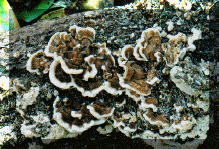 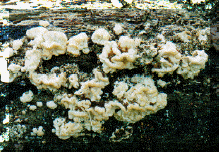 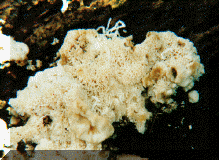 |
||||
| Polyporus floccipes
Found at Te Mata Trust Park on November 18, 2000 growing on a dead log. Also Found in a pear orchard growing from ground, but possibly buried wood!! Cap: 2-5cm in diameter, White or pale in colour with brown scales on it's surface. Depressed in the center. Stem: 2-4cm high and about 0.5cm thick. Pores: Relatively large, easily seen by the naked eye, yellowish or light orange brown in colour. Runs down the stem!! Spore print: White. (Click link to see spore print) |
 |
||||
| Polyporus sp.
Found in Te Mata Trust Park in Havelock North in July, 2000. On dead wood under a tree in a cluster of three mushrooms. Cap: Fan shaped, laterally joined to the stem. Topside dark gray in colour and covered in black hairs. Cap margin in curved. Pores: Pore surface white. Small, barely visible pores, looks smooth to the naked eye. Running down the stem. Stem: 0.5-1cm thick and 1.5-3cm high. Dark brown to black in colour. Numerous stems attached in a cluster from the base. This mushroom was growing in a very dark corner under a tree, I still can't imagine how I managed to see it!!! I have not been able to identify this mushroom's species but I am still working on it. If you have any clues please let me know. Edibility: Unknown. ( If in doubt, throw it out!!)
|
 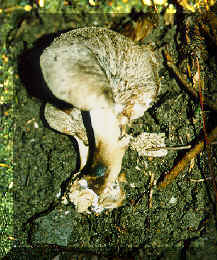 |
||||
| Group: Stereaceae (Crust and
Parchment Fungi) Thin bracket like mushrooms. Some have stems others don't. Pore layer smooth or wrinkled. |
|||||
| Sterium fasciatum
Found in Te Mata Trust Park in Havelock North, Tangoia Falls in Hawkes Bay and In the Manawatu Gorge Track through out July, 2000. Cap: Thin and bracket like. Sometimes growing flat on wood surface as if it were a stain but often separating from the wood surface to form a shelf like structure. Upper surface smooth to velvety, yellow to orange in colour darkest at connection withthe host and the colour growing paler towards the margin evntualy becoming white at the edge. Pore layer: Smooth. White or yellowish in colour. Pores are barely visible. Stem: Absent. Edibility: Too tough |
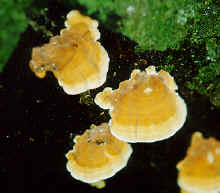 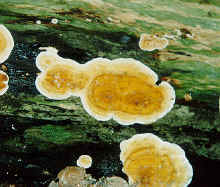 |
||||
| Group: Trametes This group of annual mushrooms can be found year round. They are tough and grow in large numbers on dead wood. Caps have concentric zones and are more or less velvety. |
|||||
| Pycnoporus coccineus Cinnabar or Red polypore Found at the Tangoia scenic reserve in Hawkes Bay on September 16, 2000 growing from a dead cabbage tree log. I was quite excited when I found this mushroom because of it's colour, a spectacular bright red to orange all
over. The cap colour faded a little to a pale orange but the pores maintained their magnificent colour. |
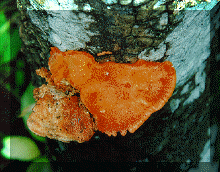 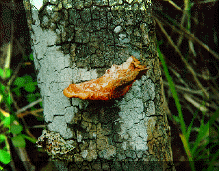 |
||||
| Trametes versicolor (The Turkey Tail)
This mushroom was found on a dead tree stump in a line of shelter belt trees in an orchard. It was a spectacular site especially when the whole tree stump was covered by them, but most of them were destroyed by an orchard lawn mower before I got to them!! Cap: Thin, upper surface with concentric zones of black, brown white yellow and often red. Zones alternate, some are smooth and others are velvety or hairy. About 2-8 cm wide. Pores: Surface white to slightly yellowish small but seen by the naked eye. Stem: Absent!! Edibility: Believe it or not, it is supposed to be edible, but you need to boil it for like 3 days
first!! This mushroom is very very common. |
 Lower pore surface. |
||||
| Trametes hirsuta (Hairy turkey tail)
Found at Tangoia Falls on October 5th, 2000. This mushroom is quite interesting, the hairs covering it's surface are quite striking. The hairs are white or
silver in colour while the cap surface is mostly whitish but is concentrically zoned. About 2-10cm in diameter, grows shelf like from wood, single or in groups as in this one. Pore Surface white and attractive in appearance. Stalk absent, broadly attached to the host!! It's texture is not too tough and not soft, similar to T. versicolor. Edibility: I would not have thought so, but like T. versicolor it is known to be edible but also needs a long cooking period!! |
  |
||||
| Unknown Polypores The following Mushrooms I have not been able to identify, if you have any clues as to what they are please contact me and let me know!! |
|||||
| Unknown 1
Found growing on dead wood at the Gorge Track in Palmerston North. Top surface light brown in colour and uneven. 3-4cm wide. No stem but broadly attached to it's host. As for edibility: I don't know what it is, so I don't know if it is edible, but I would guess not because it is rather tough and small!! |
 |
||||